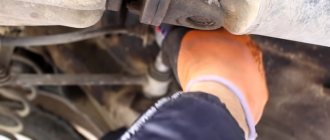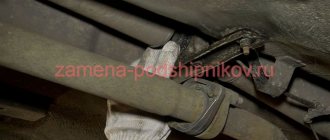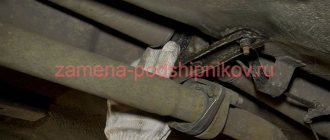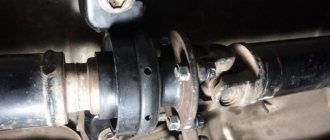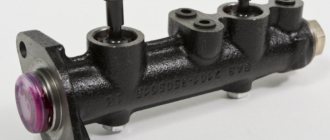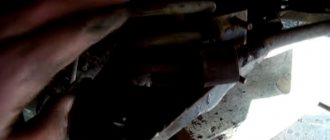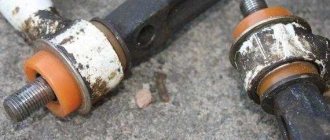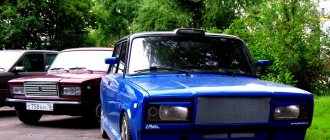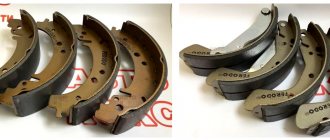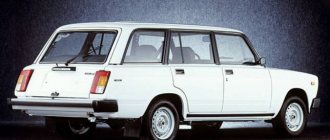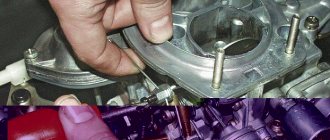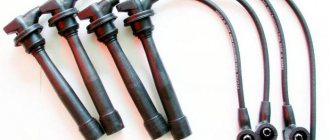We have a VAZ 2105 car, manufactured in 2010, with a mileage of 58 thousand km under repair; it is necessary to replace the reaction rods (rods) on the rear axle suspension. We will show you how to do this procedure yourself; the instructions are also applicable for VAZ 2107, VAZ 2106.
We lift the car. We press the bridge with a hydraulic strut so that the shock absorber is untied and the spring does not fall out. If you will be working on the ground, you can use an additional jack. Nuts 19, unscrew the lower mount of the rear shock absorber:
And another bolt next to it:
Now let's move on to the fastenings of the rods themselves:
We take out the old rod and take a new one, we have rods from the KEDR company, order number MK-01-2919100, new fastening bolts were also purchased for them in advance, their order number is 21010-2919000-86. Before installation, lubricate all fasteners with copper grease so that during further repairs they can be unscrewed without any problems. Install in reverse order.
Then unscrew the top short reaction rod:
Then the front bar:
There are washers on both sides at the front, remove them and replace them with new ones. Using a mounting tool, unscrew the bridge a little to insert the bolt:
After tightening your pants, you can remove the panhard rod:
Fasteners on the other side:
In order to then insert a new bolt into this place, you will again need a mounting tool, which we will use to press out the spring.
Rear suspension of the VAZ-2107 - design and methods for checking serviceability
The design of the rear suspension of the 7 is practically no different from the suspensions of other classic models of the VAZ family. The dependent suspension modification is somewhat outdated and is associated with the presence of a rigid connection between the rear wheels. Of course, a rigid connection has a great advantage - high reliability, as well as ease of maintenance, but there are also some disadvantages. To find out about them, let’s take a closer look at the rear suspension design of the VAZ 2107.
Seven rear suspension design
The rear suspension design of the VAZ 2107 is quite simple, which is required by the presence of a rear axle. It is due to the presence of the rear axle that the rear wheels are rigidly connected to each other. The rear axle beam is suspended from the body using reaction rods, of which there are only 5 in the design - four longitudinal rods and one transverse rod.
The main purpose of the longitudinal rods is to prevent and prevent the beam from moving in two directions - forward and backward. Transverse traction is needed in order to prevent the beam from moving when lateral loads occur. You need to know all the suspension parts in order to identify faults and make correct repairs.
This is interesting! To combine the rods with the body part and the beam, special hinges are used, which are made of rubber material and are called silent blocks.
We continue to study the structure of the rear suspension of the seven, and it is worth highlighting another important element - the springs. The lower part of the springs is in contact with the bowl on the bridge beam. To soften contact and prevent squeaks, a thick rubber gasket is placed between the spring and the bowl. The upper part of the springs also rests against the body bowls through an insulating gasket.
Vehicle vibrations are damped using a pair of telescopic shock absorbers. The load that is formed when the vehicle moves on uneven roads is reduced due to the presence of seven three rubber compression seals in the rear suspension design. Two seals are located in the spring structure, and the third is located on the bottom above the rear axle housing. For ease of understanding of all of the above, below is a diagram of the rear suspension of the seven.
- springs;
- telescopic shock absorbers;
- rod or transverse rod;
- axle beam connecting the wheels;
- longitudinal upper rods or rods;
- longitudinal lower rods.
How to check the condition of the rear suspension elements of a VAZ 2107
The opinion that the seven’s suspension has increased strength and wear resistance is not at all a reason for not monitoring its condition. The suspension condition of a car that is operated in off-road conditions or on poorly paved roads (there are still a large number of them left in the post-Soviet countries) especially needs to be checked.
The easiest and most effective way to check the condition of the rear suspension of the seven is a visual inspection. To do this, the car needs to be driven onto an overpass or placed over an inspection hole. Particular attention should be paid to such suspension elements as:
Diagnostics of the upper ball joint
To carry out the work you need to use help. Place an assistant in the car, behind the driver's seat, so that he squeezes the brake. Only in this case will you eliminate the possibility that during diagnostics you will be able to feel the wheel bearing being displaced.
Use sharp movements to rock the front wheel. If suddenly there is even the slightest play in the ball joint, you will definitely feel it. When pushing back and forth, the wheel will move freely. It is possible that there will be a creaking or crunching noise coming from the upper ball joint.
How to change jet rods on a VAZ 2107 with your own hands
If the car remains stable while driving, it will be safe. This rule is equally relevant for passenger cars and trucks. The VAZ 2107 was no exception. The car could never boast of high handling. That's why engineers developed a system with jet thrusts. But even such elements can fail, raising questions about independent replacement.
- Purpose of thrust rods on the VAZ 2107
- Jet thrust malfunctions and possible consequences
- Checking the condition of the jet rods on the VAZ 2107
- Test sequence
- Video checking jet rods on a VAZ 2107
- Selection of thrust rods
- Replacing jet rods on a VAZ 2107
- Removing jet rods
- Repair and installation of jet rods
- Video of changing jet engines on a VAZ 2107
- Replacing bushings and silent blocks on VAZ 2107 rods
- Sequencing
- Conclusion
How is the repair carried out?
Do-it-yourself repair of a VAZ 2106 chassis can include a wide range of works, including:
- Adjusting the bearings on the hubs.
- Replacement of grease and bearing seals.
- Replacement of front suspension shock absorbers.
- Replacing springs in pairs.
- Installing new joints on the upper and lower control arms.
- Replacement of arms, both upper and lower.
- Replacing anti-roll bar cushions on a VAZ 2106.
- Installing new upper or lower supports.
After completing all of these or one of the listed works, it is necessary to have the wheel alignment done in a specialized workshop.
Purpose of thrust rods on the VAZ 2107
Tie rods provide protection against swaying and loss of control on the road, during sharp turns and obstacles. Even earlier versions of the car had similar problems. But inside the cars there were only ordinary springs; no one knew anything about the system with rods.
It is for this reason that the vehicle caused many problems when driving. Only over time the suspension was modified. A system was installed with several long rods. This part carried the main load.
Classic VAZ 2107 cars and other models contain the following version of the torque rod kit:
- Long.
- Short.
- A large transverse one, which also serves as the basis for the entire system.
Installation location - near the car axle located at the rear. The system is visible only from the inspection hole, where repair work is usually carried out if the reaction rods are replaced.
Jet thrust malfunctions and possible consequences
If the load causes the axle to sway or shift, the impact will be taken by the jet thrust. The appearance of defects in parts leads to a deterioration in the overall behavior of transport. Damaged parts need to be replaced as quickly as possible.
The following factors often cause breakdowns:
- Exposure to chemicals from road compounds in winter;
- Impact of torsional loads. Occurs more often when colliding with obstacles. Only reducing the speed before these elements reduces the risks;
- Static loads. This factor is only reduced by the absence of overloads; it is impossible to completely get rid of it when operating rods on a VAZ 2107.
It is important to detect deformation, chips and cracks in a timely manner, for which periodic inspection of the entire system is organized. Welding seams and silent blocks are weak points that receive the most attention during inspections.
Silent blocks of any type are rubber, so they wear out faster than metal parts. Due to their wear, backlashes appear, becoming an obstacle to the stabilizing function. Welded joints, when they break, also lead to unpleasant consequences. It is recommended to remove them as quickly as possible.
With broken parts, driving is worse. Added to this is the unstable behavior of the body when defects appear in the jet rods.
Checking the condition of the jet rods on the VAZ 2107
100 thousand kilometers - new parts from the car are enough for this period, according to existing instructions. But the actual service life rarely exceeds 80 thousand kilometers, given real conditions.
The same instructions say that it is recommended to organize checks every 20 thousand kilometers. And here the experts recommend reducing the period by 5-10 thousand km to make it easier to avoid unpleasant surprises. You can’t do without an inspection hole and a mounting blade; this is the only way the jet thrust can be opened for viewing and other actions.
Test sequence
The steps are not that complicated:
- Installation of transport on a viewing hole or on an overpass;
- Mounting blades are inserted behind the traction eyes;
- The spatula rests against the jet thrust bracket. An attempt is made to shift the part, together with the silent block. If the action is successful, it means the part is worn out and needs to be replaced;
- Repeating a similar procedure with each silent block. If it moves sideways by a few mm, the need for replacement is obvious.
The rods themselves, along with the eyes, are also checked for wear. If any defects are detected, in this case the bushings and other parts are replaced.
Video checking jet rods on a VAZ 2107
Step-by-step instruction
1. Jack up and remove the wheel.
2. Unscrew the bolt securing the ball joint from the steering knuckle. Use a wrench with a 16mm head to turn the nut, and use a 16mm wrench to hold the head of the bolt.
After unscrewing, if the bolt cannot be removed by hand, we help it come out with a drift to size.
3. Now we need to remove the ball pin from the fist. To do this, take a flat screwdriver and lightly hammer it into the wedge where the fastening bolt was located. With this action we will “wake up the finger”. Next, take the pipe, insert it into the lever and push the pipe down until the finger comes out. If the finger does not come out, you can help a little with a hammer at the moment when tension is applied to the pipe. Use a hammer to hit the lever in the direction where your finger comes out.
4. If you have a Logan with a stabilizer, then you need to unscrew the stabilizer link. You need to hold it on top of the lever under Torx T40 and unscrew the nut thirteen from the bottom of the lever.
5. Move the protective cover to the side to gain access to the lever mounting bolts. Threaded clip. Unscrews by hand.
6. Unscrew the nut and bolt marked below. They strengthen the traction. The nut on the lever is an eighteen key, the top bolt is a thirteen key.
After unscrewing, remove the rod.
7. Unscrew the two bolts securing the lever and remove the lever.
Please note that the front lever mounting bolt is longer than the rear one. It is longer due to the fact that a rod is also attached to it. 8
Check the condition of the ball joint and measure the hole on the arm for the stabilizer link. The hole should not be larger than 16 mm, a maximum of 1 mm of wear is allowed. If your hole is normal and the ball is live, then it makes sense to change the silent blocks. If something is wrong with any of the above, then it is cheaper and more profitable to replace the lever assembly
8. Check the condition of the ball joint and measure the hole on the arm for the stabilizer link. The hole should not be larger than 16 mm, a maximum of 1 mm of wear is allowed. If your hole is normal and the ball is live, then it makes sense to change the silent blocks. If something is wrong with any of the above, then it is cheaper and more profitable to replace the lever assembly.
If you follow the manufacturer's recommendations, then in general it is recommended to always replace the lever assembly.
9. Before pressing out the silent blocks, we measure their extension as shown in the photo below. New ones need to be planted approximately the same, 1-2 mm is allowed.
We select a mandrel so that it rests around the silent block against the lever. We select the head according to the size of the silent block. We clamp this thing in a vice and squeeze the silent block into the mandrel. If the silent block does not come out completely, we help it a little with a hammer.
We carry out this procedure with two silent blocks.
10. Lubricate the outer part of the silent blocks with a little oil. Next, we select the size of the heads so that one head presses on the silent block holder, and it fits into the other. We clamp it in a vice and, controlling the size, press it in.
The distance from the beginning of the silent block to the edge of the lever is approximately 7 mm. If your silent block is not quite straight, it’s okay. On new original levers they are often not level.
11. We perform reverse assembly. Among the assembly nuances, it is worth noting that the bolts for fastening the silent blocks of the lever must be tightened from the hole when the wheel is loaded.
Also pay attention to the bolt securing the ball joint pin. Make sure that the thread is not pulled. If the bolt is damaged, it only needs to be replaced with the original bolt.
I think there is no need to explain what will happen if the bolt securing the ball pin breaks. Ball bolt tightening torque 60 N.m
If the bolt is damaged, it should only be replaced with the original bolt. I think there is no need to explain what will happen if the bolt securing the ball pin breaks. Ball bolt tightening torque 60 N.m.
There are no more assembly nuances, everything is in reverse order. If you have any questions, please ask below in the comments.
Replacing jet rods on a VAZ 2107
It is necessary to prepare a kit with tools and consumables in advance. Their main list is as follows:
- Hammer;
- Set with open-end wrenches. The reinforced double type parts are sometimes difficult to remove without additional tools;
- Blades for installation;
- WD-40 – this composition removes rust;
- A set with new reaction rods, including a transverse one.
When everything is ready, they begin the work itself.
Removing jet rods
Removing old parts is the first step where work begins.
The process involves the following sequence:
- A wire brush is used to remove rust and dirt from threaded connections. Then WD-40 is used for processing. You will need to wait some time before the work can continue. The instructions are also relevant for the classic model.
- Completely unscrew the nut, due to which the washer is held on the free side. This process is difficult, it is better to take a long wrench and, if necessary, re-treat the surface with WD-40.
- Dismantling the bolt and nut, moving to the other side. The rear parts are dismantled in almost the same way.
- Unscrewing the nut from the lower shock absorber mounting. The bolt with the spacer sleeve is also removed.
- Shift towards the shock absorber itself. Otherwise you won't be able to access the second bolt.
- Clean the bolt threads with a wire brush, then apply WD-40 again.
- Unscrew the nut and pull out the bolt. The elastic band also changes if necessary.
The bolt is simply cut off if the nut cannot be unscrewed. Removing the reaction rods involves using a spatula for installation. Remains of the fastening must be removed if the bolt had to be cut off.
Reverse welding of cracks will not help when they appear on the surface. The seam then still cannot withstand the load. Such parts can only be replaced in full.
Repair and installation of jet rods
Reuse is permissible only if the metal part remains intact. Rubber silent blocks must be replaced in any case. The old parts are removed from the lugs and then new ones are installed. Treating the surface with dishwashing detergent simplifies this process.
New rods are installed in the following order:
- The traction eye is mounted in the front bracket;
- The securing bolt is lubricated with nigrol, lithol. Everything is inserted into the bracket and tightened with a nut;
- The tie rod eye is inserted into the rear tie rod bracket;
- Insert the bolt with lubricant, then secure with a nut.
A situation is acceptable when the holes at the traction eye and the bracket do not coincide with each other. Then take a mounting blade and, if possible, correct the current position.
The lower part of the shock absorber at the rear is secured when the bulk of the work is completed.
Video of changing jet engines on a VAZ 2107
Removing the lower arm
When a VAZ 2106 chassis is being repaired, it may be necessary to replace the lower front suspension arm. To work, you will need wrenches 13 and 22. First, remove the front suspension spring, and then, using a wrench, unscrew the two nuts that hold the arm to the cross member. Remove it from the cross member bolts without removing the silent blocks, axle and ball joint. If necessary, replace the ball joint or change the lever. Reinstall it in the reverse order of disassembly.
Replacing bushings and silent blocks on VAZ 2107 rods
Silent blocks with bushings are disposable parts that need to be replaced immediately. In a garage, restoring parts becomes impossible. To replace you will need to acquire the following things:
- The beard is 10 mm in diameter.
- Hammer.
- Press-fitting device. It may also be needed when the rear axle is being repaired.
Sequencing
Follow the above instructions when removing the traction. Parts must be pre-treated with WD-40. A wire brush helps remove dirt and dust. Further actions are performed according to the specified algorithm:
- After removing the rod, the bushing should be removed without problems;
But this behavior is typical for parts without serious rust, with severe wear. Otherwise, you will have to use a hammer to knock the structure out of its place. The beard is inserted inside first.
- They get rid of the silent block if the rubber part is damaged too much. Use a screwdriver or a mounting shovel to pry up parts that prevent everything from being freed;
- Using a sharp knife or sandpaper, carefully clean the surface of the eyelet inside. Remains of rubber and rust should then disappear completely;
- A new bushing is placed in the eye and pressing is carried out using new equipment;
- The beard helps to cope with this part of the work. The main thing is to act carefully to avoid damage.
Articles
Renault produces silent blocks both individually and assembled with levers. The part is designated as follows: 6040002245 (60 40 002 245). Analogues:
- 26304 (FEBI)
- 60 92 6304 (SWAG)
- TD729W (DELPHI)
- C8617 (LYNXauto)
- 30292 (ASAM)
- 4500001 (FORMPART)
- 53210 or 33124 (MAPCO)
- FZ90454 (FORTUNE LINE)
- L25819 (MONROE)
- 38DC1002 (AS METAL)
- V46-0268 (VAICO)
- MGZ-508014 or 72-1956 (MAXGEAR)
- 5103924 (NK)
- F8-7977 (OPTIMAL)
- D300165 (DENCKERMANN)
- 4340201409 or EMS8502 (JP GROUP)
- DC11001 or B56112 (RIW)
- 57-00732 (TALOSA)
- 8500 25819 (TRISCAN)
- 77-00862-SX (STELLOX)
- 31242 01 (LEMFORDER)
- RESB3746 (MOOG)
- JBU751 (TRW)
It seems that the last three are praised. But there is nothing better than the original. And the cheapest analogue is produced by SWAG.
